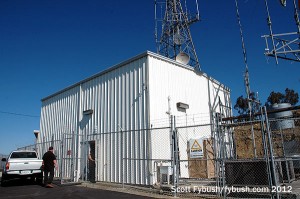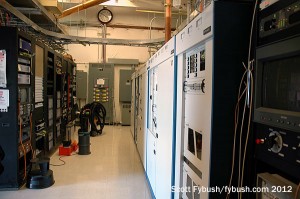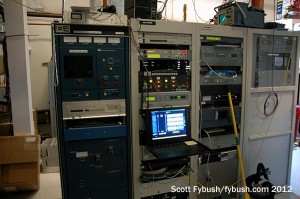NorthEast Radio Watch 3/24/2025: WJIB Makes Its Move
In this week’s issue… New signal for Boston's WJIB - "New Standards" changes stations - New home for Maine FM - Remembering NYC's Diaz, Maine's "Mr. Mike," Albany's McGrath, Rochester's Petschke
Text and photos by SCOTT FYBUSH
For any given broadcast market you can think of out west, there’s a mountaintop or two where the TV and FM broadcasters have congregated. A few weeks ago in this space, we took yet another drive up Mount Wilson near Los Angeles – but on that trip in April 2012, Wilson was just one of several major southern California mountaintops on our agenda.
 |
 |
In fact, just a couple of days after driving down from Wilson, we found ourselves headed up the road to a sight we’d only seen before from a great distance. This is Mount San Miguel, 2500 feet or so above sea level and about 10 miles east-southeast of downtown San Diego – but while it’s the highest point close in to the San Diego metro area, it wasn’t a broadcast site until the 1960s. The early development of TV and then FM in San Diego stayed closer to the coast, most notably on much shorter Mount Soledad in La Jolla, just north of downtown.
Mount San Miguel came into play when UHF television made its halting debut in town in late 1965. As the third TV station in San Diego, KAAR (Channel 39) should have been an ABC affiliate, joining established Mount Soledad-based VHF signals KFMB-TV (Channel 8, CBS) and KOGO-TV (Channel 10, NBC). But ABC was already settled in the market, too, on Tijuana’s XETV (Channel 6), so KAAR launched as an independent. Then its transmitter building burned down a year later, leaving the station silent until it was resurrected in 1968 as KCST. We’ll come back to it in a moment…
 |
 |


…after we look at the second TV station to make Mount San Miguel its home. Educational TV arrived in San Diego in 1967 by way of KEBS-TV (Channel 15), which took its present calls of KPBS-TV three years later. KEBS-TV was actually preceded by its radio sister station, KEBS (89.5), but the FM didn’t come up here until a few years later. And when we arrived here in early 2012, KPBS-FM was getting ready to move off San Miguel; it took up residence at Mount Soledad just a few months after our visit.
To get up here to Mount San Miguel, you have to drive out to the end of San Diego’s eastward freeway sprawl, out past where the 94 freeway turns into just plain State Route 94, then up some unmarked farm roads and past the gate to the paved road up to the top. Just before the very top of the mountain, the road splits, with one fork going left to the north side of the mountaintop and the other going right to the very highest part on the south side.
We go left first, and that brings us to the metal-sided KPBS building and the tower next to it, where a crossbar still holds the old KPBS-TV analog antenna and the newer KPBS-TV digital (RF 30) antenna, with KPBS-FM sidemounted below. Inside, the analog and digital transmitters still fill much of the building, with the FM transmitters down at one end (and a little messy, since the move to Soledad is already underway at this point.)
 |
 |
With KPBS-FM’s departure later in 2012, only one full-time FM signal remained on the mountain, and it wasn’t much of a signal. If you were with us back in 2010, you might recall our visit to California’s Imperial Valley, wherein we stopped by KSIQ (96.1 Brawley) just a year or so before it pulled up stakes from little Brawley and traded its big class B signal for a much smaller B1 licensed to Campo, east of Mount San Miguel. Why aim a signal into the side of a mountain? Why, because it allows for an on-channel booster right on the top of that mountain, of course! The 700 directional watts of KSIQ-FM-1 did not, as it turns out, do a particularly good job of penetrating the core of the San Diego market, and they disappeared completely in the affluent North County suburbs. But it was good enough, apparently, for owner Cherry Creek to sell KSIQ and its booster to EMF Broadcasting, which just flipped it to Air-1 as KYDO very recently.
 |
 |
We didn’t get inside any of the buildings at the south end of the mountaintop, which is where three commercial UHF stations make their homes. Remember KAAR, the pioneering independent that became KCST? In 1973, it persuaded the FCC to revoke ABC’s authorization to send its programming across the border to XETV (which we saw back in 2008), thus shifting the ABC affiliation here to channel 39. ABC moved to channel 10 a few years later, which made KCST an NBC affiliate – and much later, as KNSD, an NBC owned-and-operated station. (It’s now on RF 40, and I believe the photo above at right was taken at its gate, at the end of the south road around the mountaintop.)
Two more Us came on here in 1984: KUSI (Channel 51) has stayed independent all along under the ownership of Texas’ McKinnon family, and it’s now near the center of the mountain at a site with two towers. I think one was analog 51 and the other is KUSI’s digital signal on RF 18, but I’m far from certain; they’re both in the background at right in the photo at right above. And KTTY (Channel 69) became KSWB-TV when it became a WB affiliate, then kept those calls when it went CW and later when Tribune made it a Fox affiliate, once again poaching an affiliation from XETV. It’s on RF 19 from a side-mounted antenna next door to KNSD.
There’s also been FM here on and off, mostly on a tower down the slope of the south end of the mountaintop. Family Radio operated KECR-FM (93.3 El Cajon) up here, but under Clear Channel the station became KHTS-FM and moved down to the KGB (101.5) tower in the city. There are, or have been, auxes up here for several other San Diego FMs, including KYXY (96.5), KSON-FM (97.3) and KIFM (98.1).
 |
 |
Mount San Miguel is only a few miles from the Otay Mesa border crossing, and you can easily look into Mexico from up here (and vice versa – these towers are visible from the Mount San Antonio tower farm in Tijuana!)
But to actually see the studios of a bunch of those Mexican-licensed stations, we have to move away from the border, heading back into the city and up to the Sorrento Valley sea of hotels and chain restaurants and office parks. Off Mira Mesa Boulevard, we find an unassuming office building at 6160 Cornerstone Court that has the odd distinction of being home to two sort-of-competing clusters of Mexican-licensed stations operated by US broadcasters.
Finest City Broadcasting used to share the nearby quarters of Clear Channel Radio (we saw those in 2008, too) before moving its stations – “Z90” XHITZ 90.3, “91X” XETRA-FM 91.1 and “Magic” XHRM 92.5 – to one suite on the first floor here.
 |
 |
But we’re headed just down the hall to the next suite of studios, home to the Broadcast Company of the Americas’ three stations. The big gun here is XEPRS (1090), the signal that was Wolfman Jack’s southern California home in the 1970s as XERB. After a few decades speaking Spanish, it returned to English as the big sports station for San Diego, known today as “The Mighty 1090.” Its talk studio takes pride of place right off the lobby, with a big wall of TVs for the hosts to look at on one side, and windows into control rooms on the other side. (We saw the XEPRS towers south of the border back in 2008, too…)
One of those control rooms doubles as the studio for XEPE (1700), which carries an ESPN Radio feed but also shares Padres coverage with 1090 and breaks off for other sports, too.
 |
 |
Down that back hallway that leads to the 1090 and 1700 control rooms, we also find BCA’s FM signal. XHBCE (105.7) was a fairly recent addition to the Tijuana FM dial; it spent some time as XHPRS, simulcasting 1090 as “Double X Sports Radio” before breaking away to do oldies as “105.7 the Walrus.” Our tour guide this lovely San Diego afternoon is none other than expatriate Rochesterian Dave Mason, who was the afternoon jock on the Walrus until just last year…when he got the call to head north up the 5 to become assistant PD at the legendary K-Earth in Los Angeles…which means we have some LA visits in our future.
And we leave you at a site that isn’t there anymore: back out in Santee, east of San Diego, the six-tower array of KCBQ (1170) was a landmark for decades. We saw it standing in 2001, but a decade later it was gone, replaced by a big-box hardware store. But unlike all those other DAs that have disappeared without a trace, the top-40 legacy of KCBQ attracted enough of a passionate following that its admirers actually paid for a big honking granite monument to the station, which now adorns a corner of the shopping center’s parking lot.
Thanks to Rockley Curless at KPBS, Dean Imhof at KSIQ and Dave Mason at BCA for the tours!
 The 2014 Tower Site Calendar has been years in the making.
The 2014 Tower Site Calendar has been years in the making.
But the wait is over. The Tower Site Calendar, 2014 edition, is still shipping daily and ready for immediate hanging on your wall.
Need a calendar or two? Place your order today and we’ll send them right off to their loving homes, spiral bound, shrink wrapped and best of all, with a convenient hole for hanging!
This year’s gorgeous electronic pinups include the iconic towers of Catalina Island, a combiner system in St. Louis, the twin towers of KNRS in Salt Lake City, a historic rooftop site in Jamestown, New York and many more!
Click here to order your new calendar!
Then check out our store page for our other great merchandise, including the last-ever FM Atlas, the new NRC AM Log and a model of the KSAN tower.
And don’t miss a big batch of San Diego IDs next Wednesday, over at our sister site, TopHour.com!
Next week: NBC, Burbank – A Look Back
In this week’s issue… New signal for Boston's WJIB - "New Standards" changes stations - New home for Maine FM - Remembering NYC's Diaz, Maine's "Mr. Mike," Albany's McGrath, Rochester's Petschke
A look at two of the Voice of America facilities that were abruptly shuttered this month
In this week’s issue… FCC seeks rule changes - Townsquare, Cumulus close struggling stations - WIRY shuts down - Cumulus spawns "Cat Country" - Toronto's Citytv moves
In this week’s issue… Audacy cuts hit nationwide - Townsquare takes more signals silent - Buffalo's Lillis signs off - Mass Broadcasters name new HOF inductees - PA anchor sues Nexstar